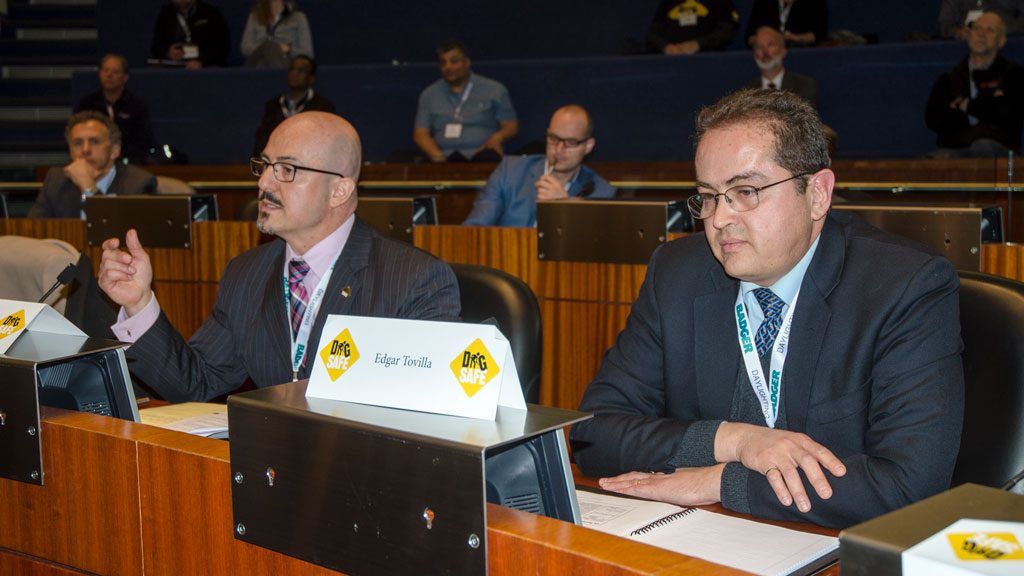Ian Wisdom, health and safety manager for Entera Utility Contractors, says there are seven words that make his blood run cold: “that’s the way we’ve always done it.”
“The number one issue is overestimating capabilities and experience,” he said, adding workers need to understand the seriousness of a misstep especially when working on underground infrastructure.
“Quite often people in the safety profession talk about the young workers being the ones that are vulnerable and most at-risk but seasoned, experienced workers are also at great risk because of that familiarity factor.”
Wisdom was among several panellists who gathered at the Dig Safe: Construction Safety in the GTA event hosted by the City of Toronto in partnership with the Ontario Regional Common Ground Alliance (ORGCA) recently.
Contractors, owners, government, locators and regulators all discussed ways to work together to decrease the number of incidents causing damage to underground infrastructure and agreed education, awareness and communication is key.
The event featured a number of panels on gas, oil, electricity, telecommunications, municipal infrastructure and safety.
“What we want people to do is think before you break that ground, ask yourself ‘have I got everything that I need to this safely?’ ” said Sat Virdi, regional supervisor for the Technical Standards and Safety Authority, adding a quick call to Ontario One Call for locates can save time and money.
“Call or click before you dig” was a phrase that was repeated various times throughout the event as April is Dig Safe Month.
Locates are our eyes, without them we cannot navigate the labyrinth of interconnecting and criss-crossing utilities
— Giovanni Cautillo
Ontario Sewer and Watermain Construction Association
“We see a real need for better communication protocols and education among ground disturbance stakeholders so that everybody involved in the excavation is precisely aware of their roles, responsibilities and associated costs of non-compliance,” said Scott Shrieber, field and training supervisor for multiVIEW Locates.
“If 40 per cent of damages are the result of an excavator not securing a locate prior to the dig, then there is definitely more work to be done. The key in safe excavation involves planning ahead, wait for all your all clears, respect the marks and communicate effectively. These need to be understood by all involved in the ground disturbance activities.”
John Huber, manager of distribution protection for Enbridge Gas Distribution, said outreach and education through the ORGCA and other channels will go a long way but infrastructure owners can also do their part.
“We as infrastructure owners can take an active role through incident investigation and lessons learned through our own damages and also implement corrective and preventative actions to help drive the best practices to support our industry goal of zero damage,” said Huber.
Jason Edwards, general manager of PVS Contractors, said it is important to communicate the importance of a locate request for any construction project, especially in the digital age.
“Are excavators in the city trained on ORGCA best practices or do we leave them to their own devices hoping they will call for a locate, hoping they will excavate safely, hoping they can read and understand a locate?” asked Edwards. “If the organizations and individuals here today truly want to make an impact, they need to invest in communication and education of digging safe.”
Giovanni Cautillo, executive director of the Ontario Sewer and Watermain Construction Association, said safety is always top of mind although many think it’s all about the bottom line for contractors.
“Contractors at no point in time wake up in the morning and state ‘boy, I hope one of my workers gets injured today.’ When it comes down to it, health and safety is our first and foremost priority on every job site every day,” said Cautillo.
Lack of accurate, timely and detailed locates prior to excavation prevents contractors from doing their job properly and safely and puts underground utilities, workers and the public at risk, he added.
“Locates are our eyes, without them we cannot navigate the labyrinth of interconnecting and criss-crossing utilities that exist underground,” he noted.
He suggested project authorities need to focus on subsurface utility engineering (SUE) which provides a higher level of information.
“It is detailed, three-dimensional, cross-sectional information and don’t tell me you can’t do it because I know it exists,” stated Cautillo.
“We live in a three-dimensional world, why aren’t we given all three dimensions when we’re excavating? We live in a technological age and we should be better relying on that technology to provide contractors with the relevant details necessary to dig.”











Recent Comments
comments for this post are closed